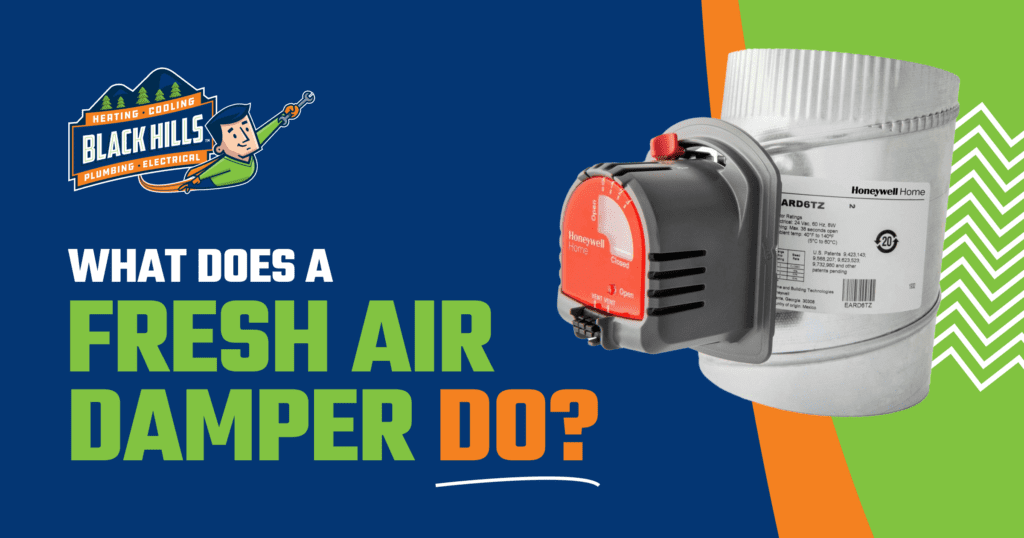Dampers may be found in various parts of an HVAC system. Dampers are placed inside your air ducts and vents, and they open and close to allow or prevent air from passing. Your air handler blows air through your air ducts at a constant rate, and the rooms closer to the air handler would receive more air than rooms further away. The most common use of dampers is to slow down airflow in the closer rooms to ensure that all the rooms are conditioned at an equal rate.
A fresh air damper, sometimes called an outside air damper, is a similar device that is placed on your fresh air intake. It works similarly to dampers elsewhere in ductwork but allows air in from outside. The fresh air intake is the duct leading from outside to the air handler (before the fan), at a point where air can enter the system.
Now let’s answer the question, “What does a fresh air damper do?” in more detail.
How a Fresh Air Damper Works
A fresh air intake with a damper should be closed when your HVAC system is off so that conditioned air doesn’t escape your home. The fresh air damper should be open when the AC or heater is on so fresh air can be allowed in.
When the fresh air damper is open, outside air can enter the structure through a vent inlet on the roof or sidewall. This air passes through a filter before passing through a duct and into the return plenum. It then mixes with the return air. The supply ducts then disperse the mixture of air throughout the building.
Not every fresh air damper is created equal. Aside from having volume dampers to control the amount of airflow in fresh air ducts and shutoff dampers that seal off the duct from outside when the blower motor shuts off, there are three basic types of fresh air dampers:
- Motorized Dampers: An electric motor controls the damper; this is the most commonly used type in HVAC systems.
- Manual Dampers: The damper is operated with a handle or knob, so you can essentially open and close one by hand.
- Automatic Dampers: These automatic dampers are modulated based on feedback from a sensor that monitors the amount of fresh air required.
Benefits of a Fresh Air Damper
Many people may ask, “Does a fresh air damper improve indoor air quality?” There are two main benefits of a fresh air damper. The first is that it pressurizes a building; more air is delivered inside, and then is pulled from the structure, creating positive pressure while the fan is running. This positive pressure helps prevent pollutants from getting pulled in from outside.
By controlling air infiltration, it’s also possible to reduce heat loss or gain from leaks in your home’s insulation. Generally, having five to ten percent outdoor air by volume can maintain a fresh indoor air supply.
In addition to bringing in fresh air to dilute polluted or stale indoor air, an outdoor fresh air damper can contribute to improved energy efficiency. Fresh air furnace dampers are beneficial to combustion appliances.
They can provide increased oxygen to enable more efficient combustion. Flue draft pressure can be increased as well, so fumes and fuel by-products are well-ventilated. The fresh air intake must have access to clean air to pull indoors in order to see any of these benefits.
Fresh Air Inlets Can Increase Heating or Cooling Load
An important consideration is the intake’s effect on the system’s heating or cooling load. To calculate the increase in load in British Thermal Units (BTUs):
- Measure how much fresh air is pulled into the building in cubic feet per minute (cfm).
- Determine the difference between the temperature inside your home and outside.
- Subtract the outdoor temperature from the indoor temperature for a season.
- Multiply the cfm value by the temperature difference (to determine how many BTUs are added).
- Use this formula: Fresh Air Sensible BTU = (Fresh Air cfm x Temperature Difference) x 1.08.
Should I Install a Fresh Air Damper?
First, determine if your HVAC system has a fresh air intake.
If your HVAC system does not have one, installing a fresh air intake can have many benefits, but there are a few considerations when designing and installing a damper. An HVAC professional can determine whether a fresh air damper is present and meets your needs, or they can install one with these important considerations in mind.
Black Hills can help with fresh air damper installation, air duct cleaning, and other indoor air quality services. We’ll help you determine if you need a fresh air intake or a damper, and we’ll install, set up, and test your fresh air intake to ensure it gives quality fresh air while keeping energy efficiency high.
For assistance in the Olympia, Washington area, schedule an appointment online or call 888-402-3514 today.

